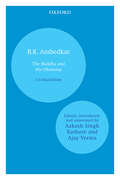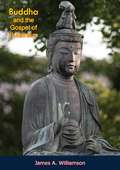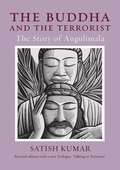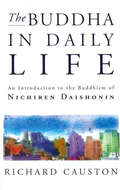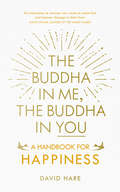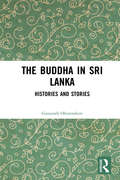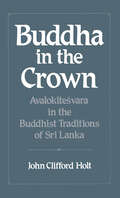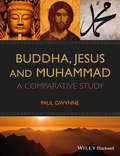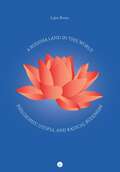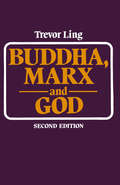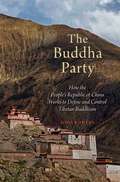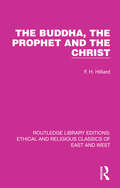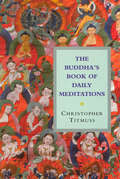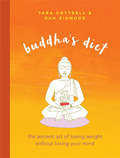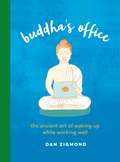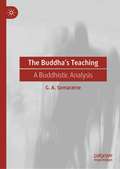- Table View
- List View
The Buddha and His Dhamma: A Critical Edition
by B.R. AmbedkarThe Buddha and His Dhamma was B.R. Ambedkar's last work. Published posthumously, it presented a radical reorientation of Buddhist thought and literature, aptly called navayana. It deals with Ambedkar's conceptualization of Buddhism and the possibilities it offered for liberation and upliftment of the Dalits. It presents his reflections on the life of the Buddha, his teachings, and the spread of Buddhism by interweaving anecdotes with detailed analyses of the religion's basic tenets. The author also includes important elements of the Buddhist canon and tradition to make the teachings more accessible. In the first critical and annotated edition of this work, the editors address the on-going debate on Ambedkar's interpretation of the Buddha's dhamma by focusing on the accuracy of his citations and providing missing sources. They also discuss Ambedkar's modification of source materials. The introduction contextualizes the scholarly work related to the text.
Buddha and the Gospel of Buddhism
by Ananda Coomaraswamy“THE aim of this book is to set forth as simply as possible the Gospel of Buddhism according to the Buddhist scriptures, and to consider the Buddhist systems in relation, on the one hand, to the Brahmanical systems in which they originate, and, on the other hand, to those systems of Christian mysticism which afford the nearest analogies. At the same time the endeavour has been made to illustrate the part which Buddhist thought has played in the whole development of Asiatic culture, and to suggest a part of the significance it may still possess for modern thinkers.“The way of the Buddha is not, indeed, concerned directly with the order of the world, for it calls on higher men to leave the marketplace. But the order of the world can only be established on a foundation of knowledge: every evil is ultimately traceable to ignorance. It is necessary, then, to recognize the world for what it truly is. Gautama teaches us that the marks of this life are imperfection, transcience, and the absence of any changeless individuality. He sets before us a summum bonum closely akin to the Christian mystic conception of ‘self-naughting.’ Here are definite statements which must be either true or false, and a clearly defined goal which we must either accept or refuse. If the statements be false, and if the goal be worthless, it is of the highest importance that the former should be refuted and the latter discredited. But if the diagnosis be correct and the aim worthy, it is at least of equal importance that this should be generally recognized: for we cannot wish to perpetuate as the basis of our sociology a view of life that is demonstrably false or a purpose demonstrably contrary to our conception of the good.“This book is designed, therefore, not as an addition to our already overburdened libraries of information, but as a definite contribution to the philosophy of life.”—Ananada K. Coomaraswamy
The Buddha and the Terrorist: The Story of Angulimala
by Satish KumarAmong all the experiences of the Buddha, his eye-to-eye encounter with a terrorist is perhaps the most relevant and vital for those of us caught in the binds of the early 21st century. Once upon a time in northern India, there lived a violent and fearsome outcaste called Angulimala ('necklace of fingers'). He terrorised towns and villages in order to try to gain control of the state, murdering people and adding their fingers to his gruesome necklace. The Buddha set out to meet Angulimala, and with the power of love and compassion he persuaded him to renounce violence and take responsibility for his past actions. Thus Angulimala was transformed. The Buddha and the Terrorist brings a message for our time about the importance of looking for the root causes of violence, and of finding peaceful means to end terror. This revised edition includes a new Prologue, 'Talking to Terrorists', in which Satish Kumar discusses how we can best deal with the phenomenon of international terrorism.By telling the tale of the pitiless, blood-splattered Angulimala, activist Satish Kumar reminds us that when the Buddha deliberately and compassionately faced real fear, the fear in that real face evaporated.
The Buddha In Daily Life: An Introduction to the Buddhism of Nichiren Daishonin
by Richard Causton CaustonNichiren Daishonin Buddhism encourages the belief that, through its faith and practices, spiritual and material blessings and benefits can be available to everyone in this life. Needs can be met, and success achieved, not merely for oneself but for others (and the world) through dedication to the Lotus Sutra, a central teaching of Buddhism. It combines these personal objectives with the commitment to world peace, ecology and the easing of suffering, especially, AIDS. Attracting such well known followers as Jeff Banks, Sandie Shaw, Tina Turner and Roberto Baggio, Nichiren Daishonin Buddhism is rooted in a Buddhist tradition going back to the teachings of Nichiren in the 13th century, and is part of an international movement based in Japan.
The Buddha in Me, The Buddha in You: A Handbook for Happiness
by David HareDo you want to be happier? Find inner calm? Enjoy a rich and rewarding life? Here's how... The Buddha in Me, the Buddha in You combines the tried-and-tested wisdom of Nichiren Buddhism with the best of popular psychology and personal development, making this a brilliant guide to how life works, and how to get the most from it. Nichiren Buddhism differs from other Buddhist schools in its focus on the here-and-now, and places great importance on individual growth as the starting point for a better world. This, combined with powerful techniques such as NLP, mindfulness, journalling and coaching, makes The Buddha in Me, the Buddha in You the quintessential handbook for happiness.'Buddha' simply means someone who is awakened - yet while Nichiren Buddhists will find fascinating insights into their practice, there is no need to follow a spiritual path to benefit from this book. Through his experience as an internationally acclaimed life coach and practising Buddhist, author David Hare shows us how to wake up to our own potential and that of those around us – to discover everyday enlightenment.
The Buddha in Sri Lanka: Histories and Stories
by Gananath ObeyesekereThis book examines culture, religion and polity in the context of Buddhism. Gananath Obeyesekere, one of the foremost analytical voices from South Asia develops Freud’s notion of ‘dream work’, the ‘work of culture’ and ideas of no-self (anatta) to understand Buddhism in contemporary Sri Lanka. This work offers a restorative interpretation of Buddhist myths in contrast to the perspective involving deconstruction. The book deals with a range of themes connected with Buddhism, including oral traditions and stories, the religious pantheon, philosophy, emotions, reform movements, questions of identity and culture, and issues of modernity. This fascinating volume will greatly interest students, teachers and researchers of religion and philosophy, especially Buddhism, ethics, cultural studies, social and cultural anthropology, Sri Lanka and modern South Asian history.
The Buddha in Sri Lanka: Histories and Stories
by Gananath ObeyesekereThis book examines culture, religion and polity in the context of Buddhism. Gananath Obeyesekere, one of the foremost analytical voices from South Asia develops Freud’s notion of ‘dream work’, the ‘work of culture’ and ideas of no-self (anatta) to understand Buddhism in contemporary Sri Lanka. This work offers a restorative interpretation of Buddhist myths in contrast to the perspective involving deconstruction. The book deals with a range of themes connected with Buddhism, including oral traditions and stories, the religious pantheon, philosophy, emotions, reform movements, questions of identity and culture, and issues of modernity. This fascinating volume will greatly interest students, teachers and researchers of religion and philosophy, especially Buddhism, ethics, cultural studies, social and cultural anthropology, Sri Lanka and modern South Asian history.
Buddha in the Crown: Avalokitesvara in the Buddhist Traditions of Sri Lanka
by John Clifford HoltHistorical, anthropological, and philosophical in approach, Buddha in the Crown is a case study in religious and cultural change. It examines the various ways in which Avalokitesvara, the most well known and proliferated bodhisattva of Mahayana Buddhism throughout south, southeast, and east Asia, was assimilated into the transforming religious culture of Sri Lanka, one of the most pluralistic in Asia. Exploring the expressions of the bodhisattva's cult in Sanskrit and Sinhala literature, in iconography, epigraphy, ritual, symbol, and myth, the author develops a provocative thesis regarding the dynamics of religious change. Interdisciplinary in scope, addressing a wide variety of issues relating to Buddhist thought and practice, and providing new and original information on the rich cultural history of Sri Lanka, this book will interest students of Buddhism and South Asia.
Buddha is Dead: Nietzsche and the Dawn of European ZEN
by Manu BazzanoDrawing on Zen as well as on Nietzsche's thought and its ramifications in and for western culture, this book is a fervent call for a re-visioning of philosophy as vocation. The author is critical of the status quo and committed to intellectual integrity; the result is a creative and adventurous enterprise which is no longer exclusively identified with academia or with the methodology of logic. Filtered through Nietzsche's hammer -- by which he sounded out gods old and new -- Buddhism in the West can avoid the pitfalls which emerged during its gestation period in the twentieth century: otherworldly spiritualism, conservatism, denial of the body. The philosophy of European Zen advocated by Manu Bazzano in 'Buddha is Dead: Nietzsche and the Dawn of European Zen' is an unconditional affirmation of living and dying to their fullest. It is an extraordinary fertile viewpoint that will be appreciated by all those who are interested in Eastern philosophy and religions, and who seek life-affirming wisdom.
Buddha, Jesus and Muhammad: A Comparative Study
by Paul GwynneThis cool, clear-sighted comparative study has no theological axe to grind. It offers a trusty thematic guide to the figureheads of three of the largest religions in the world. The comparative approach is descriptive and even-handed, highlighting both similarities and differences across a range of major areas. The thematic chapters cover: early life, followers, the core message, political attitudes, relations with women, and death. The engaging writing and descriptive approach make this an ideal text for students, instructors and general readers.
Buddha, Jesus and Muhammad: A Comparative Study
by Paul GwynneThis cool, clear-sighted comparative study has no theological axe to grind. It offers a trusty thematic guide to the figureheads of three of the largest religions in the world. The comparative approach is descriptive and even-handed, highlighting both similarities and differences across a range of major areas. The thematic chapters cover: early life, followers, the core message, political attitudes, relations with women, and death. The engaging writing and descriptive approach make this an ideal text for students, instructors and general readers.
A Buddha Land in This World: Philosophy, Utopia, and Radical Buddhism
by Lajos BronsIn the early twentieth century, Uchiyama Gudō, Seno’o Girō, Lin Qiuwu, and others advocated a Buddhism that was radical in two respects. Firstly, they adopted a more or less naturalist stance with respect to Buddhist doctrine and related matters, rejecting karma or other supernatural beliefs. And secondly, they held political and economic views that were radically anti-hegemonic, anti-capitalist, and revolutionary. Taking the idea of such a “radical Buddhism” seriously, A Buddha Land in This World: Philosophy, Utopia, and Radical Buddhism asks whether it is possible to develop a philosophy that is simultaneously naturalist, anti-capitalist, Buddhist, and consistent. Rather than a study of radical Buddhism, then, this book is an attempt to radicalize it. The foundations of this “radicalized radical Buddhism” are provided by a realist interpretation of Yogācāra, elucidated and elaborated with some help from thinkers in the broader Tiantai/Tendai tradition and American philosophers Donald Davidson and W.V.O. Quine. A key implication of this foundation is that only this world and only this life are real, from which it follows that if Buddhism aims to alleviate suffering, it has to do so in this world and in this life. Twentieth-century radical Buddhists (as well as some engaged Buddhists) came to a similar conclusion, often expressed in their aim to realize “a Buddha land in this world.” Building on this foundation, but also on Mahāyāna moral philosophy, this book argues for an ethics and social philosophy based on a definition of evil as that what is or should be expected to cause death or suffering. On that ground, capitalism should be rejected indeed, but utopianism must be treated with caution as well, which raises questions about what it means – from a radicalized radical Buddhist perspective – to aim for a Buddha land in this world.
The Buddha Party: How the People's Republic of China Works to Define and Control Tibetan Buddhism
by John PowersThe Buddha Party tells the story of how the People's Republic of China employs propaganda to define Tibetan Buddhist belief and sway opinion within the country and abroad. The narrative they create is at odds with historical facts and deliberately misleading but, John Powers argues, it is widely believed by Han Chinese. Most of China's leaders appear to deeply believe the official line regarding Tibet, which resonates with Han notions of themselves as China's most advanced nationality and as a benevolent race that liberates and culturally uplifts minority peoples. This in turn profoundly affects how the leadership interacts with their counterparts in other countries. Powers's study focuses in particular on the government's "patriotic education" campaign-an initiative that forces monks and nuns to participate in propaganda sessions and repeat official dogma. Powers contextualizes this within a larger campaign to transform China's religions into "patriotic" systems that endorse Communist Party policies. This book offers a powerful, comprehensive examination of this ongoing phenomenon, how it works and how Tibetans resist it.
The Buddha Party: How the People's Republic of China Works to Define and Control Tibetan Buddhism
by John PowersThe Buddha Party tells the story of how the People's Republic of China employs propaganda to define Tibetan Buddhist belief and sway opinion within the country and abroad. The narrative they create is at odds with historical facts and deliberately misleading but, John Powers argues, it is widely believed by Han Chinese. Most of China's leaders appear to deeply believe the official line regarding Tibet, which resonates with Han notions of themselves as China's most advanced nationality and as a benevolent race that liberates and culturally uplifts minority peoples. This in turn profoundly affects how the leadership interacts with their counterparts in other countries. Powers's study focuses in particular on the government's "patriotic education" campaign-an initiative that forces monks and nuns to participate in propaganda sessions and repeat official dogma. Powers contextualizes this within a larger campaign to transform China's religions into "patriotic" systems that endorse Communist Party policies. This book offers a powerful, comprehensive examination of this ongoing phenomenon, how it works and how Tibetans resist it.
The Buddha, The Prophet and the Christ (Ethical and Religious Classics of East and West #1)
by F. H. HilliardOriginally published in 1956, this book brings together from the canonical writings of Buddhism, Islam and Christianity the most important of the passages in which the view of the Founder is reflected. It aims to let each of the sacred traditions tell its own story and only such comments have been added as seem necessary to bring out the full significance of the passage quoted. The final chapter summarizes some of the difficult questions which arise from a comparison of the extracts from the 3 traditions.
The Buddha, The Prophet and the Christ (Ethical and Religious Classics of East and West #1)
by F. H. HilliardOriginally published in 1956, this book brings together from the canonical writings of Buddhism, Islam and Christianity the most important of the passages in which the view of the Founder is reflected. It aims to let each of the sacred traditions tell its own story and only such comments have been added as seem necessary to bring out the full significance of the passage quoted. The final chapter summarizes some of the difficult questions which arise from a comparison of the extracts from the 3 traditions.
Buddha, Wisdom and Economics: A Contribution to the Art of Happiness
by S. Niggol SeoIn this innovative book, S. Niggol Seo investigates the intrinsic and intriguing relationship between the fundamental teachings of Buddhism and the principles of economics and happiness. Offering a unique perspective on the topic, Seo delves deep into the theoretical foundations of economics and Buddhist teachings, highlighting how these seemingly polar opposite thought systems cross paths.Seo argues that when it comes to markets, prices, interest rates, growth, poverty, and environmental protection, Buddhism and economics share a number of common economic ideas. Written in an accessible style, Seo presents both a succinct and encompassing description of Buddhism for economists, as well as a comprehensive overview of economics. Buddha, Wisdom and Economics brings together in a balanced and systematic way the common ground between both endeavours. It further examines important topics in the field in light of Buddhist teachings, including economic growth and happiness, poverty and environmental protection.This thought-provoking book will be an invigorating read for undergraduate and postgraduate economics students and to those with a particular interest in development economics, religion, welfare and happiness studies. It also offers ground-breaking insights for economic policy-makers looking to better understand the intersection between Buddhism and economics.
The Buddha's Book Of Daily Meditations
by Christopher TitmussAccording to Christopher Titmuss, the beneficial influence of the Buddha falls into three primary areas: non harming, meditation and wisdom. By taking apt quotations from the vast number of talks (over 10,000) which the Buddha gave during his 45 years of teaching, Titmuss offers one thought-provoking excerpt for each day of the year - and so helps illuminate these three important themes. This is a book readers will want to keep for many years, and dip into time and again.
Buddha's Diet: The Ancient Art of Losing Weight Without Losing Your Mind
by Tara Cottrell Dan ZigmondThere's a lot you probably don't know about the Buddha. For one, the real Buddha was thin. And before he became the "Enlightened One," he was a pampered prince named Siddhartha. He tried dieting once and didn't like it any more than you do. Instead, he sought a "middle way" between unhealthy overindulgence and unrealistic abstinence. The instructions he gave his monks about eating, more than 2,500 years ago, were surprisingly simple.Fast forward to today, and modern science confirms what Buddha knew all along. It's not what you eat that's important, but when you eat. You don't need to follow the latest fads or give up your favorite foods. You just have to remember a few guidelines that Buddha provided-guidelines that, believe it or not, will help you lose weight, feel better, and stop obsessing about food. Sure, Buddha lived before the age of doughnuts and French fries, but his wisdom and teachings endure, providing us with a sane, mindful approach to achieving optimum health.
Buddha's Diet: The Ancient Art of Losing Weight Without Losing Your Mind
by Tara Cottrell Dan ZigmondThere's a lot you probably don't know about the Buddha. For one, the real Buddha was thin. And before he became the "Enlightened One," he was a pampered prince named Siddhartha. He tried dieting once and didn't like it any more than you do. Instead, he sought a "middle way" between unhealthy overindulgence and unrealistic abstinence. The instructions he gave his monks about eating, more than 2,500 years ago, were surprisingly simple. Fast forward to today, and modern science confirms what Buddha knew all along. It's not what you eat that's important, but when you eat. You don't need to follow the latest fads or give up your favorite foods. You just have to remember a few guidelines that Buddha provided-guidelines that, believe it or not, will help you lose weight, feel better, and stop obsessing about food. Sure, Buddha lived before the age of doughnuts and French fries, but his wisdom and teachings endure, providing us with a sane, mindful approach to achieving optimum health.
Buddha's Office: The Ancient Art of Waking Up While Working Well
by Dan ZigmondCan enlightenment be found at the office? From the co-author of Buddha's Diet comes another book that shows how the wisdom of Buddha can apply to our modern lives -- this time exploring how Buddha's guidance can help us navigate the perils of work life. Without setting foot in an office, Buddha knew that helping people work right was essential to helping them find their path to awakening. Now more than ever, we need Buddha's guidance. Too many of us are working long hours, dealing with difficult bosses, high-maintenance coworkers, and non-stop stress. We need someone to help remind us that there is a better way. With Buddha's wisdom at the core of every chapter, Buddha's Office will help you learn how to stop taking shortcuts and pay more attention, care for yourself and others, deal with distractions, and incorporate Buddha's ageless instructions into our modern working life.It's time to wake up and start working in a more enlightened way. One that is right for you, right for our health, right for your sanity, and right for the world.
Buddha's Office: The Ancient Art of Waking Up While Working Well
by Dan ZigmondCan enlightenment be found at the office? From the co-author of Buddha's Diet comes another book that shows how the wisdom of Buddha can apply to our modern lives -- this time exploring how Buddha's guidance can help us navigate the perils of work life. Without setting foot in an office, Buddha knew that helping people work right was essential to helping them find their path to awakening. Now more than ever, we need Buddha's guidance. Too many of us are working long hours, dealing with difficult bosses, high-maintenance coworkers, and non-stop stress. We need someone to help remind us that there is a better way. With Buddha's wisdom at the core of every chapter, Buddha's Office will help you learn how to stop taking shortcuts and pay more attention, care for yourself and others, deal with distractions, and incorporate Buddha's ageless instructions into our modern working life.It's time to wake up and start working in a more enlightened way. One that is right for you, right for our health, right for your sanity, and right for the world.
The Buddha’s Teaching: A Buddhistic Analysis
by G. A. SomaratneThis book approaches the Dhamma, the Buddha’s teaching, from a Buddhistic perspective, viewing various individual teachings presented in hundreds of early discourses of Pali canon, comprehending them under a single systemic thought of a single individual called the Buddha. It explicates the structure of this thought, going through various contextual teachings and teaching categories of the discourses, treating them as necessary parts of a liberating thought that constitutes the right view of one who embraces the Buddha’s teaching as his or her sole philosophy of life. It interprets the diverse individual dhammas as being in congruence with each other; and as contributory to forming the whole of the Buddha’s teaching, the Dhamma. By exploring some selected topics such as ignorance, configurations, not-self, and nibbāna in thirteen chapters, the book enables readers to understand the whole (the Dhamma) in relation to the parts (the dhammas), and the parts in relation to the whole, while realizing the importance of studying every single dhamma category or topic not for its own sake but for understand the entirety of the teaching. This way of viewing and explaining the teachings of the discourses enables readers to clearly comprehend the teaching of the Buddha in early Buddhism.
The Buddha's Tooth: Western Tales of a Sri Lankan Relic (Buddhism and Modernity)
by John S. StrongJohn S. Strong unravels the storm of influences shaping the received narratives of two iconic sacred objects. Bodily relics such as hairs, teeth, fingernails, pieces of bone—supposedly from the Buddha himself—have long served as objects of veneration for many Buddhists. Unsurprisingly, when Western colonial powers subjugated populations in South Asia, they used, manipulated, redefined, and even destroyed these objects to exert control. In The Buddha’s Tooth, John S. Strong examines Western stories, from the sixteenth to the twentieth century, surrounding two significant Sri Lankan sacred objects to illuminate and concretize colonial attitudes toward Asian religions. First, he analyzes a tale about the Portuguese capture and public destruction, in the mid-sixteenth century, of a tooth later identified as a relic of the Buddha. Second, he switches gears to look at the nineteenth-century saga of British dealings with another tooth relic of the Buddha—the famous Daḷadā enshrined in a temple in Kandy—from 1815, when it was taken over by English forces, to 1954, when it was visited by Queen Elizabeth II. As Strong reveals, the stories of both the Portuguese tooth and the Kandyan tooth reflect nascent and developing Western understandings of Buddhism, realizations of the cosmopolitan nature of the tooth, and tensions between secular and religious interests.
